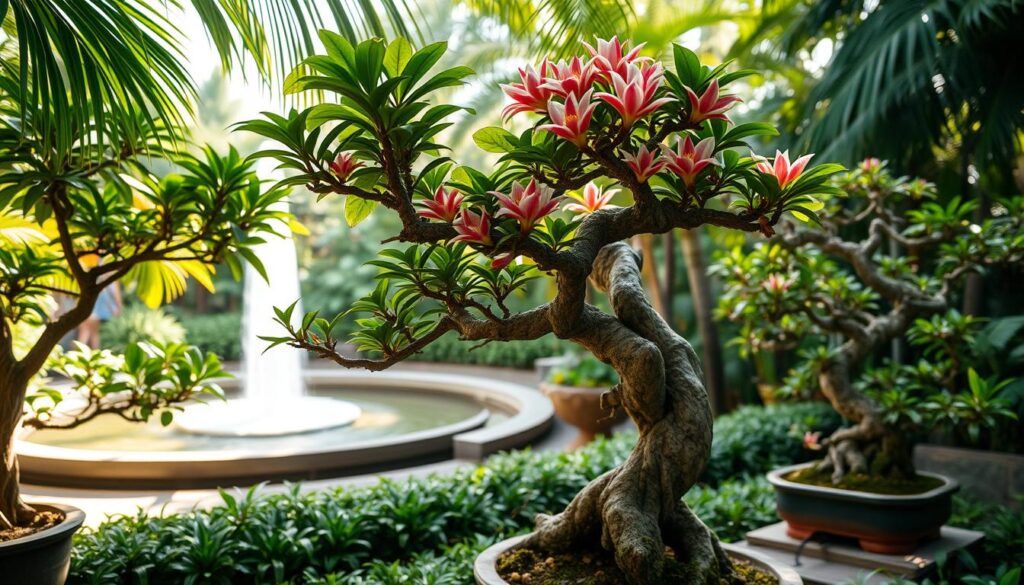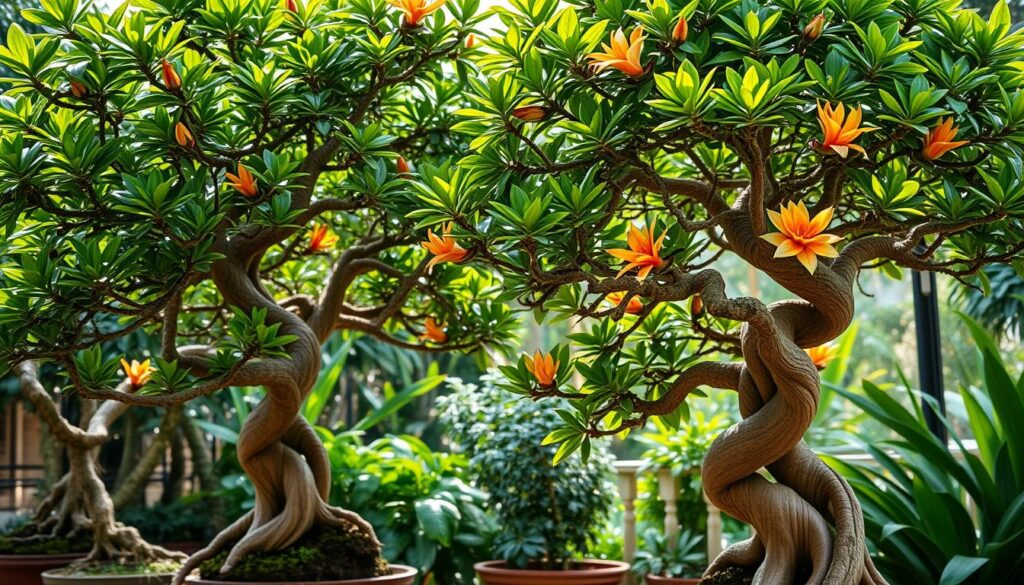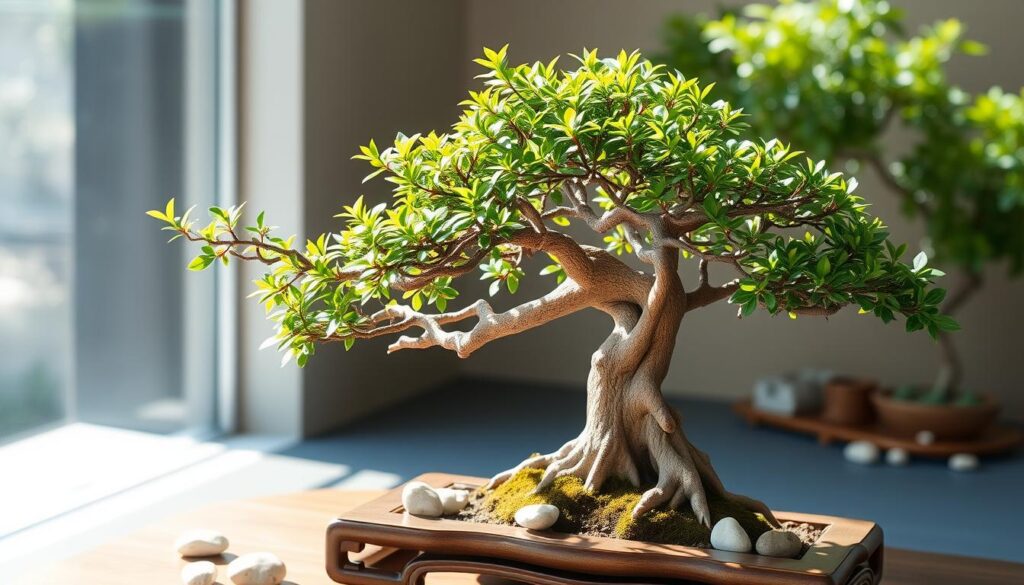Are you captivated by the mesmerizing dance of the Brazilian Rain Tree’s foliage? It closes at night and during rain. This tropical bonsai species, known as Chloroleucon tortum syn. Pithecellobium tortum, is a gem among bonsai lovers and collectors. It’s hardy, grows fast, and adapts well to different light conditions.
Key Takeaways
- Brazilian Rain Trees thrive in full to partial sun, making them a versatile choice for bonsai growers.
- These tropical bonsai trees are hardy, fast-growing, and adaptable, with a captivating foliage display.
- Collectors and enthusiasts can find rare and exquisite Brazilian Rain Tree bonsai specimens for their collections.
- Proper care and protection from freezing temperatures are essential for maintaining the health and beauty of these unique bonsai trees.
- Brazilian Rain Tree bonsai offer a fascinating natural weather indicator, closing their leaves at night and during rain.
Introduction to Brazilian Rain Tree Bonsai
The Brazilian Rain Tree, known scientifically as Chloroleucon tortum, is a unique bonsai species. It comes from the lush forests of Brazil and is part of the Fabaceae family. This family includes Acacia and Tamarind trees.
The tree’s leaves close when it rains, gets dark, or gets too hot. This makes it act like a natural weather station.
Scientific Classification and Origins
The Brazilian Rain Tree, or Chloroleucon tortum, belongs to the legume family. It has small, fern-like leaves and an attractive branch structure. This makes it great for bonsai, fitting many growing conditions.
It comes from Brazil’s tropical regions. There, it loves the warm, humid climate.
Unique Features of Chloroleucon Tortum
The tree’s leaves are its most interesting feature. They close in response to rain, darkness, or heat. This makes it look like a mimosa bonsai in action.
This natural behavior turns the Brazilian Rain Tree into a living sculpture. It draws the eye of bonsai fans and nature enthusiasts.
“The Brazilian Rain Tree’s responsive foliage is a true marvel, making it a captivating addition to any indoor or outdoor bonsai collection.”
The Natural Beauty of Brazilian Rain Trees
Brazilian Rain Trees are a favorite among bonsai lovers. They have a natural beauty that stands out. Their leaves are delicate and feathery, forming an elegant canopy.
These trees are special because they react to their environment in unique ways. This makes them even more interesting to watch and care for.
With the right care, Brazilian Rain Trees can grow beautiful branches and a strong root system. This makes them look like tiny versions of real trees. Their natural beauty combined with the artist’s skill creates a stunning sight.
“The Brazilian Rain Tree bonsai is a living work of art, a testament to the beauty and resilience of nature in its most delicate form.”
Whether you’re new to bonsai or have been doing it for years, Brazilian Rain Trees are a great choice. They are graceful and adaptable, making them a favorite in any bonsai collection. They offer endless joy and a deeper appreciation for the art of growing these miniature trees.

| Feature | Description |
|---|---|
| Foliage | Delicate, feathery leaves that create an elegant, umbrella-shaped canopy |
| Branching | Intricate branch structures that can be developed with proper care and styling |
| Nebari | Strong root flare that enhances the aesthetic value of the bonsai |
| Adaptability | Unique response to environmental conditions, adding an interactive element to their appeal |
Brazilian Rain Tree Bonsai For Sale: Finding Your Perfect Specimen
Looking for a Brazilian Rain Tree bonsai? You need to think about a few things. The tree’s size, age, and how it’s styled all affect its price. These factors are key to finding a good deal.
Pricing and Value Considerations
Prices for Brazilian Rain Tree bonsai vary a lot. The most wanted ones cost more. Trees that are bigger and older, with detailed roots, are worth more. Smaller, younger trees are cheaper but need more time and effort to grow.
Available Sizes and Varieties
Good bonsai nurseries, like Wigert’s Bonsai Nursery in North Ft Myers, have many sizes of Brazilian Rain Tree bonsai. You can find small plants or big, mature trees. Choose trees with healthy leaves and good branch structure for the best quality.
Where to Purchase Authentic Specimens
It’s important to buy from a trusted source. Known bonsai nurseries and sellers know how to find real trees. They might even have trees styled by famous artists like Erik Wigert. Don’t buy from unknown online sellers, as you can’t be sure of the tree’s quality.
“The Bonsai tree owned by master Kobayashi is reported to be over 800 years old, making it one of the most expensive Bonsai trees.”
Essential Care Requirements for Rain Tree Bonsai
To keep tropical bonsai trees like the Brazilian Rain Tree healthy, you need to know their specific needs. These indoor bonsai do well in a special environment. This includes the right amount of sunlight, water, food, and pruning.
Bonsai trees, including the Rain Tree, need at least 5-6 hours of direct sunlight a day. They should be in a bright, sunny spot. In winter, they might only need water once a week. But in summer, they might need it every day or every other day.
Keeping the humidity right is key for indoor bonsai like the Brazilian Rain Tree. Mist them often and keep them away from cold drafts. Also, they shouldn’t get too cold, as they can’t handle temperatures below 45 degrees Fahrenheit.
| Bonsai Care Requirement | Recommended Practices |
|---|---|
| Fertilization | Fertilize tropical bonsai trees, such as the Brazilian Rain Tree, once or twice per month with a mild fertilizer during the growing season. |
| Pruning and Shaping | Prune and shape tropical bonsai trees 3-4 times per year to maintain their characteristic form and encourage dense foliage growth. |
| Repotting | Repot indoor bonsai trees, like the Brazilian Rain Tree, every 2-3 years to provide fresh soil and accommodate root growth. |
| Pest Management | Use insecticides or organic sprays preventatively several times per year to protect tropical bonsai trees from pests. |
By following these care tips, you can keep your Brazilian Rain Tree bonsai healthy and beautiful. It’s a true piece of living art.

Optimal Growing Conditions and Environment
The Brazilian Rain Tree bonsai loves bright, sunny spots but can handle some shade. It does best in temperatures over 50°F (10°C). It needs protection from very cold weather.
Light Requirements
The Brazilian Rain Tree bonsai does well in full sun, needing at least 8 hours of direct sunlight daily. If it’s very hot, some shade can help avoid leaf burn. You can grow it indoors, but it needs a spot near a south-facing window for enough light.
Temperature Preferences
These tropical bonsai trees love warm weather, best between 50-90°F (10-32°C). They can handle short cool spells but cold for too long is bad for them.
Humidity Needs
- Brazilian Rain Tree bonsai prefer high humidity, around 60-80%.
- You can keep humidity up with regular misting or using trays with pebbles and water.
- Keeping humidity right is key, especially in dry winter months, to keep the tree healthy.
| Optimal Conditions for Brazilian Rain Tree Bonsai | Values |
|---|---|
| Light Exposure | Full sun to partial shade |
| Temperature Range | 50-90°F (10-32°C) |
| Humidity Level | 60-80% |
Creating the right environment for your tropical bonsai trees ensures they stay healthy and grow well.
Watering Techniques and Schedule
Proper watering is key for a vibrant living bonsai plant. For Brazilian Rain Tree bonsai, water thoroughly when the top soil layer dries. Use a watering can or hose with a fine nozzle to ensure water drains well.
In spring and summer, your bonsai might need daily watering. But in winter, water less often. Never let the soil dry out completely. Mist the leaves regularly to keep them clean and healthy.
“Watering is crucial for the Brazilian Rain Tree bonsai, as it will die if it dries out completely.”
Watch for signs of stress like wilting leaves or dry soil. Adjust your watering based on weather, pot size, and your bonsai’s needs. This will help your bonsai plants for beginners thrive.

Success in bonsai care comes from finding the right watering balance. A consistent yet flexible routine will help your bonsai flourish. This way, you can enjoy the beauty of nature indoors or outdoors.
Soil and Fertilization Guidelines
To grow a healthy tropical bonsai tree, you need to focus on the soil and how often to fertilize. Brazilian Rain Tree bonsai do best in soil that drains well but still holds moisture. A mix of akadama, pumice, and organic compost in equal parts is perfect for these trees.
Soil Composition
Choosing the right soil for bonsai plants is key. It should drain well and hold nutrients. A blend of akadama, pumice, and organic compost mimics the tree’s natural home.
Fertilizing Schedule
- Feed your Brazilian Rain Tree bonsai with a balanced fertilizer every two weeks from spring to fall.
- For older trees, slow-release organic fertilizers are great. They give nutrients steadily.
- In winter, when trees grow slower, cut back on fertilizing to avoid over-feeding.
Always use the right amount of fertilizer as suggested by the manufacturer. This keeps your tropical bonsai trees healthy. Good soil and fertilization are crucial for a thriving Brazilian Rain Tree bonsai.
“The art of bonsai is not just about creating miniature trees, but about cultivating a deep connection with nature through meticulous care and dedication.”
Pruning and Shaping Techniques
Keeping your Brazilian Rain Tree bonsai looking great needs attention and skill. Pruning is key to shaping the tree and making it look full and green. Pinching new growth helps achieve the look you want. Big pruning jobs should happen in early spring, before new growth starts.
When shaping your bonsai, use wire to guide the branches. You can make them cascade, semi-cascade, or something else. Make sure to check the wire often and take it off before it hurts the branches. The Rain Tree’s leaves are very flexible, making it easy to shape into different miniature trees and bonsai specimens.
| Pruning Technique | Timing | Purpose |
|---|---|---|
| Pinching new growth | Regularly | Encourages dense foliage pads |
| Structural pruning | Early spring | Shapes the tree’s form |
| Branch wiring | As needed | Guides the branch placement |
Learning to prune and shape your Brazilian Rain Tree bonsai unlocks its full beauty. You’ll create stunning miniature trees that everyone will admire.

Repotting Your Brazilian Rain Tree
As your bonsai plants for beginners grow, it’s key to repot them often. This keeps them healthy and full of life. The Brazilian Rain Tree, with its detailed branches and leaves, needs a new pot every 2-4 years.
The best time to repot is in mid-summer. This is when the tree is strongest. When you repot, be gentle with the roots. Cut off no more than a quarter of the roots to prevent shock. Choose a pot that’s just a bit bigger than the old one to give the roots room to grow.
- Gently remove the tree from its current pot, taking care not to damage the delicate root system.
- Prune the roots, removing no more than 25% of the total root mass.
- Place the tree in a new pot filled with fresh, well-draining bonsai soil.
- Water the tree thoroughly after repotting to encourage new root growth.
Make sure the tree is firmly planted in its new home. This helps the roots grow strong and healthy. With the right care, your Brazilian Rain Tree bonsai will flourish and bring joy for many years.
| Repotting Frequency | Optimal Repotting Time | Root Pruning Recommendations |
|---|---|---|
| Every 2-4 years | Mid-summer | Trim no more than 25% of root mass |
The Brazilian Rain Tree bonsai is a delicate plant that needs careful care. By following these repotting tips, your bonsai plants for beginners will stay healthy and brighten your space.
Common Challenges and Solutions
Keeping tropical bonsai plants for beginners healthy can be tricky. But, with the right care, you can overcome these challenges. Let’s look at the common problems and how to fix them.
Pest Management
Tropical bonsai trees face many pests like spider mites and mealybugs. It’s important to check and clean the leaves often. If you find pests, use gentle insecticidal soap or neem oil to treat them.
Disease Prevention
Tropical bonsai trees are at risk of root rot from too much water. Make sure the soil drains well to avoid this. Also, fungal diseases can grow in damp conditions. Improve air flow and avoid watering from above to prevent this.
Diseases like black spot and mildew can also harm tropical bonsai trees. Keep your bonsai clean, provide the right environment, and treat any disease quickly. This will help keep your bonsai plants for beginners healthy.
| Common Bonsai Diseases | Characteristics |
|---|---|
| Black Spot | This fungus appears as black spots or patches on the leaves. |
| Leaf Spot | Characterized by white, black, brown, or grey spots on leaves or small twigs and branches. |
| Mould or Mildew | A fungus that thrives in damp environments with insufficient sunlight and poor ventilation. |
| Rust | This fungal disease appears as yellow, orange, red, or brown raised bumps or blisters on the undersides of leaves. |
By tackling these common problems and using the right solutions, you can keep your tropical bonsai trees healthy and vibrant. Being proactive in pest and disease control is key to your bonsai plants for beginners success.

Seasonal Care and Winter Protection
Caring for your tropical bonsai trees is a year-round job. You need to pay extra attention in winter. If it gets cold, bring your indoor bonsai trees inside or protect them well.
A garage, shed, or even a simple cold frame can be a good winter home for your tropical bonsai trees. During this time, water and fertilize less because they grow slower. In milder places, outdoor bonsai trees can stay outside all year. But, they still need protection from frost and bad weather.
Change your care routine with the seasons to keep your indoor bonsai healthy. When spring comes, water and fertilize more to help them grow strong again. By meeting your bonsai’s changing needs, you can keep them beautiful for years.
“Bonsai trees can live for centuries under proper care, with examples of trees being hundreds of years old.”
Seasonal care and winter protection are key for your tropical bonsai trees‘ long life. Knowing what your bonsai needs and adjusting your care can help them thrive. They will bring joy to your home or garden.
Shipping and Handling Information
Buying brazilian rain tree bonsai online is safe. Reputable sellers use the right shipping to get your bonsai specimen to you safely. They pack the trees well, keeping the root ball moist during travel.
They use strong boxes and packing to keep the bonsai safe. You can choose ground or express shipping, depending on where you are. For big brazilian rain tree bonsai, they might need special crates, which cost extra.
- Free Shipping on orders $49 and above for FedEx Ground
- Orders under $49 ship for only $11.95
- Deliveries to West Coast addresses (West of the Rocky Mountains) will arrive in 4-6 business days
- Orders sent to the rest of the country will arrive in 1-4 business days
- Guarantee of 3-Day Delivery for FedEx Express Saver
- Guarantee of Next Business Day by 3pm for FedEx Standard Overnight
Good sellers ship your brazilian rain tree bonsai well and give you tracking info. With the right care, your new bonsai specimen will do great in your place.

“The packaging was excellent, and my brazilian rain tree bonsai arrived in perfect condition. I’m thrilled with my purchase!”
Display Tips and Aesthetic Considerations
When showing off your exotic bonsai, the right pot and placement are crucial. A pot that matches the Brazilian Rain Tree’s beauty is essential. Shallow, oval, or rectangular pots in earthy tones like terracotta or slate are perfect.
The pot should be about two-thirds the height of the tree. This makes the tree the main attraction, with the pot adding to the look.
Pot Selection
Japanese-style bonsai pots are a favorite for their simple yet elegant design. Unglazed pots in soft colors are great for outdoor exotic bonsai. On the other hand, brightly colored or patterned glazed pots are ideal for indoor bonsai specimen trees.
For small bonsai like Shohin and Mame, choose pots that fit perfectly. Pots from Tokoname, known for their craftsmanship, are often seen in bonsai shows.
Positioning Guidelines
Place your Brazilian Rain Tree bonsai at eye level for the best view. Make sure it gets the right amount of light, whether direct or indirect.
A turntable can be very helpful. It lets you rotate the bonsai for even growth and to see it from all sides. This makes the display more interesting and beautiful.
Conclusion
The Brazilian Rain Tree bonsai is a captivating choice for bonsai lovers in the UK. They have unique features like responsive leaves and elegant shapes. These tropical trees are highly sought after.
With the right care, like plenty of light and regular watering, these trees can thrive. This care ensures they bring joy for many years.
For both new and seasoned bonsai fans, the Brazilian Rain Tree is a standout. Its beauty and interactive nature make it a top pick. Many nurseries and online stores in the UK sell these trees, giving enthusiasts plenty of options.
The Brazilian Rain Tree bonsai is becoming more popular. It’s a tropical bonsai that many want. By learning how to care for these trees, bonsai fans in the UK can enjoy their beauty fully.


